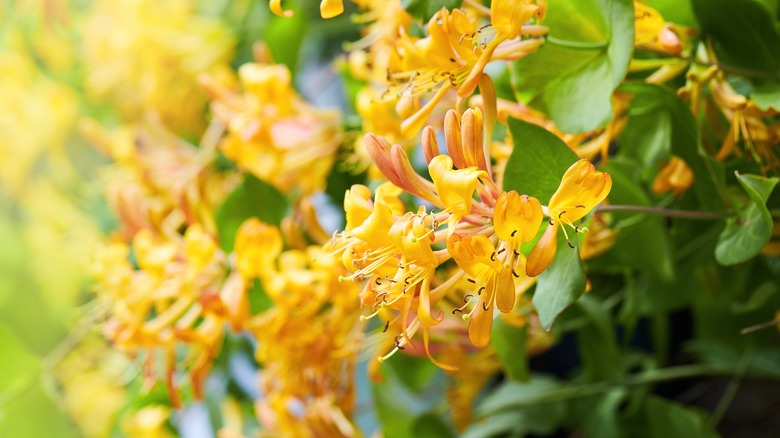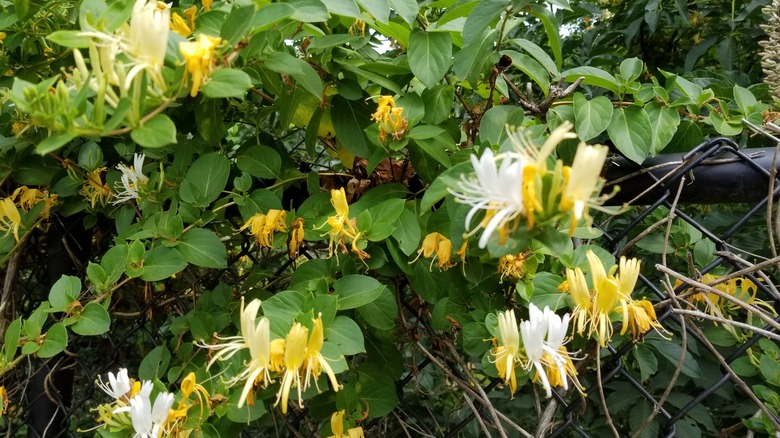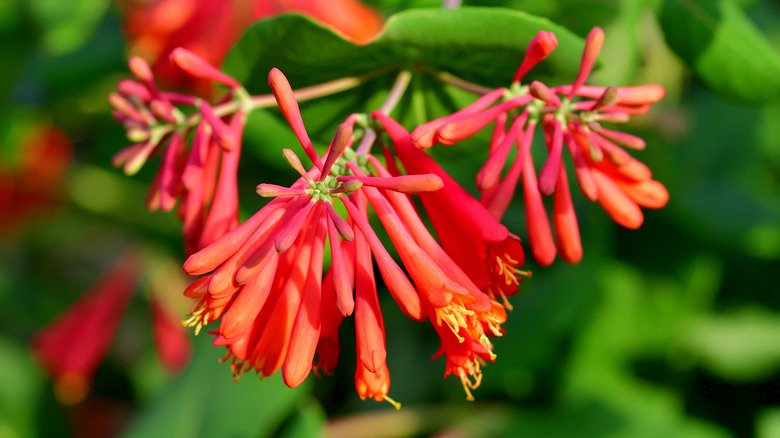How To Tell If The Honeysuckle In Your Yard Is Native Or Invasive
Having a honeysuckle vine growing in your yard can be a dream thanks to the plant's beautiful flowers and ability to attract pollinators, including bees and hummingbirds. Unfortunately, some types of honeysuckle are invasive and can quickly turn from a dream into a nightmare that outcompetes native species, is detrimental to the health of local birds, and spreads so aggressively that it takes over your yard. Learning to tell the difference between native and invasive honeysuckles by looking at their stems and leaves will help you keep detrimental plants out of your yard.
While not all non-native plants are invasive, in North America, many non-native honeysuckles definitely are. This includes the vining Japanese honeysuckle (Lonicera japonica) as well as the more shrub-like Tartarian (Lonicera tatarica), Amur (L. maacki), and Morrow (L. morrow) honeysuckles. All of these honeysuckles harm native plants and trees as they outcompete them for nutrients and sunlight. The berries from these honeysuckles are also not as nutritious for birds, and The Penn State College of Agricultural Science reports that birds who build nests in these plants often lose more chicks than those nesting in native plant species. Many states have already listed these invasive honeysuckles as noxious weeds, so you're unlikely to find them for sale at nurseries or garden centers. Unfortunately, as these invasives were once popular ornamental plants, they still thrive in many yards and gardens.
Identifying invasive honeysuckle
One of the easiest ways to identify invasive honeysuckle is by its stems. Japanese, Morrow, Tartarian, and Amur honeysuckle all have hollow stems. North American native honeysuckles, like trumpet honeysuckle (Lonicera sempervirens), on the other hand, have solid stems. This is true of both the bushier honeysuckles and the vining varieties.
Another useful way to distinguish native honeysuckles from their invasive relatives is by looking at the leaves. While the bushy fly honeysuckle (Lonicera canadensis) that is native to North America has serrated leaves, invasive shrubby honeysuckles have smooth leaf edges. Native vining honeysuckles can be identified by the fact that they usually have redder stems and less hairy leaves than their non-native counterparts. Native honeysuckles also don't grow by twining around trees or structures the way Japanese honeysuckle does. They instead grow with tendrils and aerial roots. This twining is also part of why Japanese honeysuckle is so destructive, as it can girdle trees and eventually crush and kill them.
Removing and replacing invasive honeysuckle
If you've discovered that the honeysuckle in your yard is invasive, it's best to get rid of the invasive honeysuckle before it takes over your garden. You should begin by trying to dig out and remove the honeysuckle plant. If it has spread too aggressively for that to be a practical option, then herbicides may be necessary. You can take advantage of the fact that invasive honeysuckles usually break dormancy before native species and treat the plant with a foliar herbicide in early spring when your native plants have not yet leafed out. You can also cut back the honeysuckle and then paint an herbicide onto the stump. Be sure to use gloves, goggles, and other protective equipment to safely remove these invasive species.
Your yard may look a bit empty once you've removed your invasive beauties, but replacing them with native honeysuckles will soon make your garden even better than it was before. Trumpet honeysuckle thrives in zones 4 through 9 and is a beautiful substitute for invasive Japanese honeysuckle. While it is still a vigorous grower, it's not nearly as aggressive as the Japanese variety. Fly honeysuckle can make a great substitute for invasive bush honeysuckles, as can Northern bush honeysuckle (Diervilla lonicera), which is hardy in zones 3 through 10.



